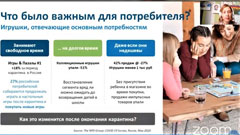Irina Sedova: the toy market turned out to be quite stable

What happened to the children's goods market not only in Russia but also in Europe? Were toys a necessary commodity when people were staying at home? What will happen in the post-quarantine period? Irina Sedova, Development Director, NPD Group, talks about this and much more.
Irina Sedova: the toy market turned out to be quite stable
– Different European countries showed different dynamics. In the first months of 2020, we had an increase of 9 %, while during the quarantine, a drop in sales reached 24%. The decrease in sales in our country was still less than in Europe. There are several reasons for that. In Southern Europe the situation with the virus turned out to be very serious, non-food retailers have been closed there since early March. In Northern Europe, the situation was better, with consumers switching more easily to online sales.
For two months, while people were staying at home, toys were in demand among consumers and were among the basic purchases. But not all toys, only those that occupy the child for a long time, even if not very cheap. During the quarantine, inexpensive toys that are impulse purchases suffered the most. Their sales fell the most, almost by half. The recovery of this segment should not be expected quickly, at least until children return to school, and the restrictions are finally lifted. A planned purchase – a birthday present, a gift for a significant event – can not be considered cheap in fact. A birthday present should be nice and not cheap.
The strongest sales growth was shown by 5 product groups: electric cars, equipment for playgrounds, family board games, puzzles for children, and goods for creativity. It is noteworthy that children's table-top games are now quite actively represented by Russian manufacturers: their share reaches 38%.
Now the customers are slowly returning to the stores. At the same time, 80% of respondents are afraid to try on goods in the store or even just touch them. 27% are not ready to take children with them. Two-thirds of respondents will continue to choose and buy products online. As the main motivation for visiting shopping centers, respondents named "the opportunity to have fun and to look at the shop-windows".
What products will be bought for children after the quarantine is lifted? Approximately 60% of consumers will be ready to buy any toy of the child's choice as a reward, compensation, or a symbol of the end of the quarantine, to please the child. It can be a long-planned purchase, a birthday purchase, or a gift. We see sales growth now is getting higher than it was last year. In the second place, there was the answer: "any toy for playing outdoors." 22 % named classic, educational toys, and only 10% named a "novelty product".
But even after the removal of all restrictions, people will not return soon to communicating outside their homes, so the entertainment items that were popular during the quarantine will still be in demand: games, creativity products, and video games.
To sum up, we can note that the toy market turned out to be quite stable. It is likely to fall significantly less than other industries by the end of the year. Why is that? Because the games and the toys turned out to be very important products for the consumers during the quarantine. People began spending more time with their children, playing more games together, and staying at home longer. Thanks to the development of online sales channels, the crisis has been a catalyst for this. People do not want to give up the acquired habit of searching for goods on the Internet first, and only after that going to the stores to touch the goods with their hands and to make a purchase. The customers will mostly go out for shopping to have an emotional experience, for entertainment. Toys are important during the crisis and after its end because they are emotional outlets that allow both the children and the parents to compensate for the lack of positive emotions. The pandemic certainly had a profound effect on the toy market, but we know for sure that on December 31, Santa Claus will come to every family with presents.


